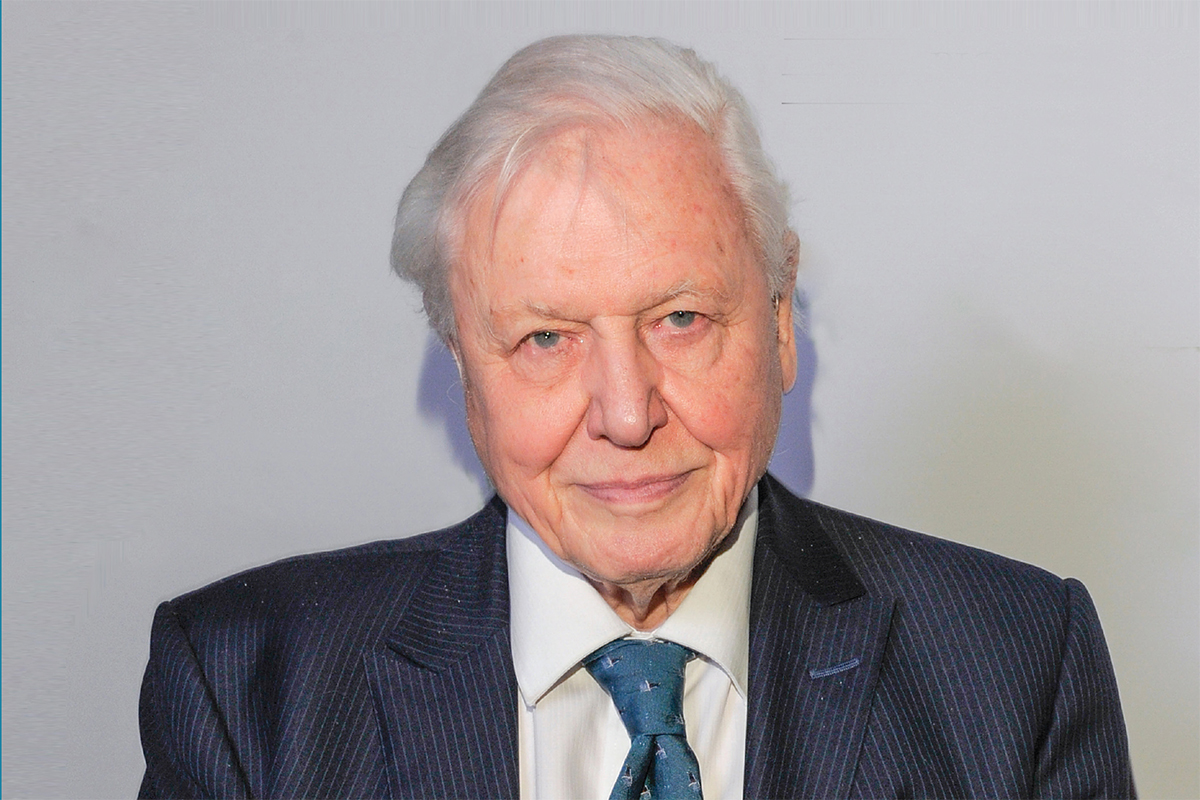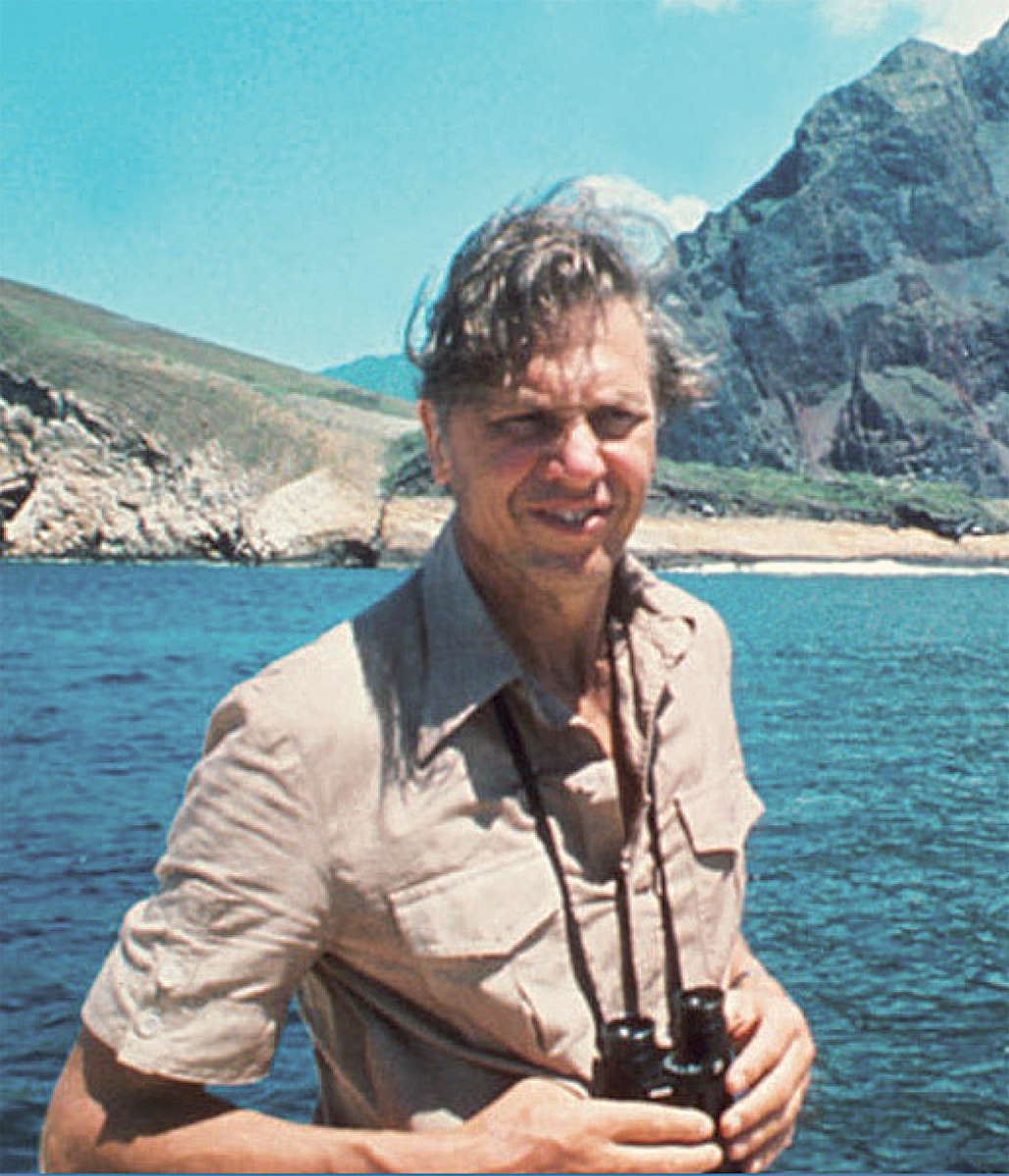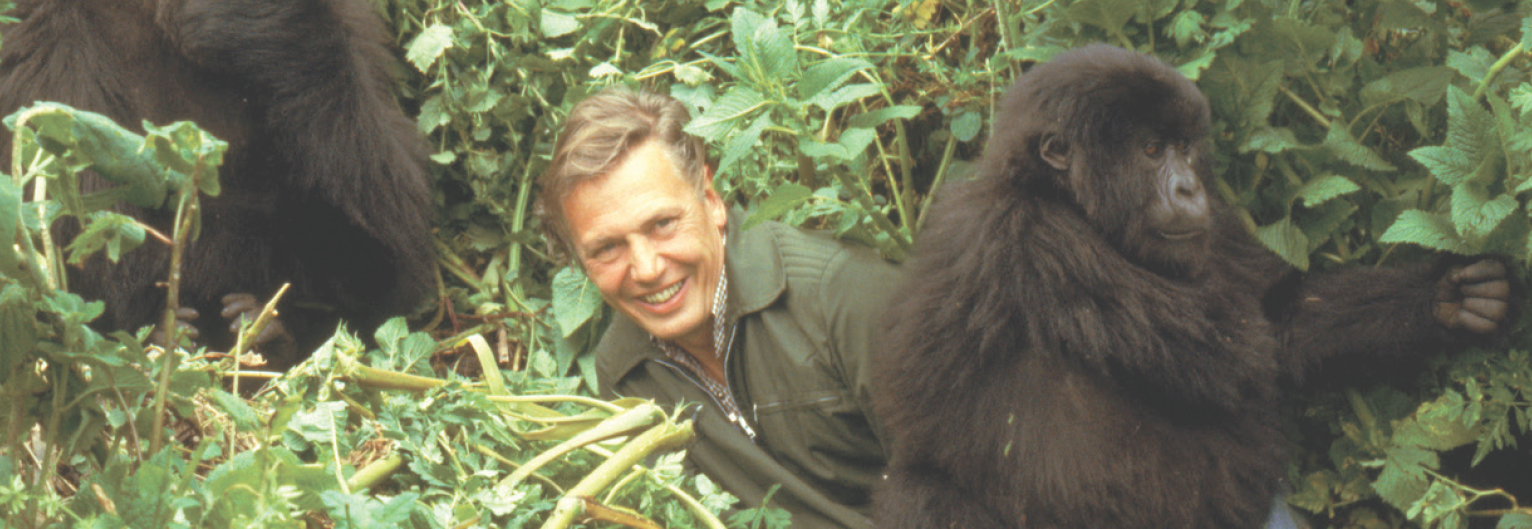
For nearly 70 years Sir David Attenborough has been exploring the planet, taking hundreds of millions of television viewers on eye-opening journeys through the natural world. Jungles and island archipelagos, deserts and deep under the sea, no place has been too remote, no animal too elusive, for Sir David and his talented team of filmmakers to document.
The man known as a national treasure is 94 years old now, but age and the pandemic haven’t slowed him down. Regarding his programmes, they are, what he calls, a witness statement, a firsthand account of what he has seen happen to the planet and a dire warning of what he believes awaits us if we don’t act quickly to save it.
Attenborough was born on May 8th 1926, 17 days after Queen Elizabeth II and, like Her Majesty, he has become a symbol of stability in a turbulent world. It is hard to imagine a time before he was on our screens, affably engaging with sloths or giant turtles – partly because there wasn’t. Television was invented the year after he was born, and only began to enter people’s homes in the 1950s, when he was beginning his career. The first programme he made was watched by barely 10,000 people gazing at 405 flickering black-and-white lines on large boxes in living rooms in the south-east of England. Recently, his series Our Planet became Netflix’s most-watched original documentary, watched by 33 million people in its first month.
Attenborough and the Queen are more than just contemporaries. “I see them quite a lot,” Attenborough said of the royal family from his home in Richmond earlier this year. He first encountered the Queen’s children, Charles and Anne, in 1958, when they toured the BBC’s Lime Grove studios and the young presenter introduced them to his pet cockatoo, Cocky. In 1986, the year after Attenborough was knighted, he produced the first of six Christmas broadcasts for the Queen. Earlier this year, he was interviewed by Prince William on stage at Davos; the future king asked him for advice on how best to save the planet.
In our fractured age, Attenborough is the closest we have to a universally beloved public figure. Last year, a YouGov poll found him to be the most popular person in Britain. The crowd at Glastonbury’s Pyramid stage roared when he appeared on stage in 2019. Viewers of Love Island expressed outrage when one contestant declared she found his programmes boring. But Attenborough transcended national treasure status some years ago. He is a truly global figure now. So many Chinese viewers downloaded Blue Planet II “that it temporarily slowed down the country’s internet”, according to the Sunday Times. When his latest series was broadcast live in South Africa and India, rapt schoolchildren held up signs: “Thank you for being you – Sir David A” and “Sir David please come to India please”.
As he moves from the White House to the World Economic Forum, urging presidents, businesspeople and the public to better protect the environment, he has come to be viewed, in a way he sees as overblown, as a keeper of humanity’s conscience. “That man who saves the world,” is how many young children describe him.
There will never be another David Attenborough. What makes him special, apart from all his personal qualities, is the timing of his life. When Attenborough began travelling the world in the 1950s, we were in a different geological epoch, the Holocene. Today, we live in the Anthropocene, an epoch defined by Homo sapiens’ disruptive dominance of the planet. He’s seen more of the natural world than any human being that has ever lived on the planet and he’s also seen more change than anyone else and he feels a responsibility.
Despite the adulation, one charge has dogged Attenborough for decades. Critics argue that he has built himself a unique storytelling platform, only to fail to tell the most important story of all: the destructive impact of people on the planet. But one reason Attenborough has thrived on screen for seven decades is because he has always sensed how attitudes are changing, and moved with the times. For a long time, he maintained that his programmes must showcase the wonders of the natural world, and not speak of the human one. Now his latest series are filled with urgent messages about environmental destruction. Still, he resists the idea that he has changed; he prefers to say that it is the public mood that has transformed. After a lifetime of caution, almost despite himself, he has become a leading champion for action.
Attenborough fell in love with the natural world as a boy, exploring his way through his neighbourhood in Leicester, looking for bugs, insects and amphibians. The middle child of three brothers, he grew up in a family of teachers. His father was principal of University College, Leicester. His mother was a talented pianist. Education was revered. He speaks of his boyhood passions – keeping tanks of tropical fish, venturing across northern England on his bike as a young teen, alone, in search of fossils.

To this day, Attenborough is still a collector – of tribal art, books and music – but although more than a dozen species are named after him, including a flightless weevil, Trigonopterus Attenboroughi, and a genus of dinosaur, Attenborosaurus, he is not an authority on natural history. “Everyone thinks he’s an amazing naturalist,” said the producer and writer Mary Colwell, who worked with him at the Natural History Unit in the 2000s. “He isn’t at all. He’s a great storyteller. Everyone thinks he makes these programmes. He doesn’t – but without him they wouldn’t sparkle in the way they do.”
Attenborough agrees. “Work and reputation get separated,” he said. Forty years ago, he travelled around the world three times in order to make his groundbreaking series Life on Earth. He wrote the script, and every page of the accompanying book. “But now I just write and speak the words. And people say: ‘What was it like when you saw that animal charging in?’ And I say: ‘I wasn’t there. Thirty cameramen worked on this thing.’ I’m given credit for things I don’t do. I am grateful, but I’m also embarrassed.”
It is even worse, he said, when viewers assume he is a source of scientific wisdom. “OK, I was a biologist once, but I’m a hopeless birder. If I go out with a birder I keep my mouth shut. I just nod. ‘Mmmm. Mmmm.’ So to use a horrible word, I’ve become a kind of icon. Using it in its original meaning, I’m the image of what they think of as a naturalist. I’m a reasonable naturalist, but I’m not the great all-seeing source of all information, knowledge and understanding.”
At times, Attenborough’s self-deprecation almost sounds like imposter syndrome. When he was asked to list his failings as a person, he narrowed his eyes. “I’m too convincing,” he laughed, comparing his own expertise unfavourably to other wildlife broadcasters such as Simon King and Liz Bonnin. “When it comes to, as it were, conning your way through, I’m not bad at it. Never identify things unnecessarily.”
"It’s really very unfair that man should have chosen the gorilla to symbolise all that is aggressive and violent, when that’s the one thing that the gorilla is not and that we are"
Even so, plenty of colleagues recall Attenborough relishing his ability to surprise them with his knowledge. Jonny Keeling, the executive producer of Seven Worlds, One Planet, was excited to show his presenter never-obtained-before footage from China of a golden snub-nosed monkey. “‘Oh yes, Rhinopithecus roxellana,’” remembered Attenborough instantly: he knew all about it and had tried to film it many years before.
The only praise Attenborough will accept is for his skill as a storyteller. Robert Attenborough, David’s son and an anthropologist at the University of Cambridge, remembered, as a teenager, “watching him in the raconteur role as a host of a dinner party and admiring the skill with which he would tell a funny story. Sometimes they get slightly improved. That’s something we used to tease him about. Of course he
wouldn’t do that, then or now, when making a serious point.”
Attenborough’s storytelling has been honed over seven decades in television – and he is, above all, a TV man. After studying natural sciences at Cambridge, he married his university sweetheart, Jane Oriel, and ditched his boring junior publishing job for the glamorous new world of television. He started off behind the camera, after one of his first bosses decided his teeth were too big for a presenter. In 1954, Attenborough travelled to Sierra Leone with Jack Lester, London Zoo’s curator of reptiles, to film a new series, Zoo Quest. The concept was simple: they would catch wild animals – their bounty from Sierra Leone included pythons, bird-eating spiders and their big prize, the bald-headed rockfowl – and bring them back to London to add to the zoo’s collection. At the outset, Attenborough was the producer, director, sound man and animal-wrangler. He only ended up being the presenter because Lester was taken ill after the first episode.
Zoo Quest was broadcast in black and white, but the original colour footage, which was later discovered by BBC archivists, is beautiful. Attenborough narrates his encounters in clipped, 1950s, BBC-issue received pronunciation, with little trace of his more expressive later style. Although the colonial animal-snatching conceit of Zoo Quest is extremely dated, each episode focuses as much on the human worlds he visits as the exotic animals. Attenborough’s script is factual, respectful and open-minded; his films unsensationally depict nudity, polygamy and other cultural traditions, alongside the animal hunt.
Over the next few years, new series of Zoo Quest appeared and Attenborough’s reputation grew. With his keen eye for the perceptions of his TV audience, he adapted cannily to a rapidly expanding industry. By the dawn of the 60s, as he admitted in his autobiography, Zoo Quest was looking “increasingly antiquated”. He realised that it was time for a new approach. His next Quest series, filmed in northern Australia, eschewed attempts to bring animals home and instead depicted the cultural lives of Aboriginal peoples.
The trip to Australia inspired him to take a part-time postgraduate degree in anthropology, but he was tempted back to full-time TV work before he could complete it. In 1965, he became controller of BBC Two, an appointment greeted with scepticism by “TV professionals” quoted in newspaper columns of the day. At first, he was considered lightweight, a youthful bit of eye-candy, but he was soon hailed for his “unexpected” success, as a Daily Express profile put it. “Everybody forgot I wasn’t just a naturalist – I was always a trained TV man,” he told the paper in 1965. “Hell, I love it. I watch everything. Straight home from the office – switch to BBC Two – see all my babies.”
As the channel’s controller and then director of programmes for both BBC channels, Attenborough was a great innovator. In 1967, the government decided that BBC Two would become the first channel to switch to colour, and he set about exploiting this advantage. He put snooker on the channel and helped devise new forms of sport: one-day cricket and rugby league under floodlights. Programmes that emerged under his watch include Dad’s Army, Porridge and Monty Python’s Flying Circus.
In 1972, he championed “community programming” that included what has been described as the first sympathetic portrayal of transgender people on British television; he even suggested phone-ins to widen audience participation, years before they became a staple of TV and radio.
One of his lasting innovations was the all-you-need-to-know documentary, beginning with Kenneth Clark’s Civilisation. Attenborough designed this epic, 12-part series about the history of art and culture to showcase the glory of colour television. These monumental series became known as “sledgehammers”, and there followed uncompromisingly highbrow treatments of human evolution, economics and US history. But Attenborough believed the best subject for sledgehammer treatment was yet to come: natural history.
Attenborough’s achievements at BBC Two made him a prime candidate for director-general, the top job at the corporation. But he was tiring of the senior executive’s life – desk-bound, constant meetings – and in the early 70s he resigned. “The fact he didn’t want to stay as an executive and wanted to go back to programming says something very important about him,” his son Robert told me. Attenborough yearned to be more creative, and had seen the thankless politics involved in the top job. “The Archangel Gabriel couldn’t do the DG’s job,” he remarked.
Instead, he persuaded the BBC that he could create a Civilisation-style treatment of the evolution of plants and animals. This series took three years to make, and the budget was so big that Attenborough had to pitch to US networks for funding. (He still enjoys impersonating a sceptical American TV man aghast at the prospect of funding a series that opened with “slime mould”.)

Life on Earth was broadcast for 55 minutes on 13 consecutive Sunday evenings in 1979. It “started quietly,” according to Mike Salisbury, a former producer who worked on the programme. Despite the presence of a safari-suited Attenborough, binoculars around his neck, skipping between exotic locations, the early episodes often feel like a lecture with moving pictures. Our handsome presenter tries to make the best of diagrams of DNA, micro-organisms and 200m-year-old fossils. “A whole lot of worms have left this delicate tracery of trails in what was mud,” he enthuses in the Grand Canyon. Salisbury chuckled at the difficulty of bringing this to life on television: “Fossils, for God’s sake. They don’t even move.”
But as its epic story slowly unfolds, the series warms up. The writing is often superb: “Four million animals and plants in the world,” says Attenborough, “four million different solutions to staying alive.” The penultimate episode, on primates, features the first memorable Attenborough “two shot”, where he appears alongside another animal. He joins a grooming session among mountain gorillas in Rwanda, and still has the presence-of-mind to whisper: “There is more meaning and mutual understanding in exchanging a glance with a gorilla than any other animal I know.” Although some facts have changed – we now know there are more than 8m species, not 4m – the series stands the test of time; one Cambridge professor still shows his undergraduates the primates episode each year.
For old-timers at the BBC, history is divided into before and after Life on Earth. “We hadn’t realised what a game-changer it was going to be,” said Salisbury. “By the end there were 14 million people watching it.” The series established what television executives call the “blue-chip” natural history blockbuster. While the BBC has relinquished its dominance over most genres, it remains the pre-eminent maker of natural history programmes. Much imitated, these blockbusters are still a huge global export: the BBC will not reveal what profit, if any, these series make, but Planet Earth II and Blue Planet II were sold to more than 235 territories.
For most of his life, Attenborough’s environmentalism has been the old-fashioned, off-screen variety, lending his support to numerous green charities. Ever since he was asked, as a bit of a joke, to open a visitor centre at a nature reserve by the village of Attenborough in Nottinghamshire, in 1966, he has given rousing speeches at hundreds of events for nature charities across Britain. It is hard to find a visitor centre at a Wildlife Trust nature reserve that does not feature a silver plaque declaring that it was “Opened by Sir David Attenborough”.
To his critics, these good deeds do not make up for what they see as Attenborough’s great failing as a broadcaster. Putting the case for the prosecution, the journalist George Monbiot has accused Attenborough of “knowingly creating a false impression of the world” by making films that underplay humanity’s impact on the planet and fail to identify the forces driving mass extinction and the climate crisis. Another environmentalist told me that Attenborough possesses irreproachable integrity, but his long silence on extinction and global warming in his television work has contributed towards a popular knowledge deficit. Even so, his public reticence and natural caution have made the final stage of his career all the more striking.
In November 2004, nearly 20 years after the phrase “global warming” was first coined, Attenborough attended a lecture in Belgium given by Ralph Cicerone, an American expert on atmospheric chemistry. The graphs that Cicerone presented, showing the rise in global temperatures, finally convinced Attenborough, beyond any doubt, that humans were responsible for the changing climate. Attenborough insists he was never a sceptic about man-made climate change; just cautious. Even after Cicerone’s lecture, he still believed his job was to make programmes about wildlife. He worried that people would think he was setting himself up as an expert on climate science.
Attenborough’s output changed, however. This distinction may mystify those beyond the Natural History Unit, but its film-makers distinguish between natural history and “environmental” film-making. The former focus on animal or plant biology and behaviour; the latter address environmental issues. Attenborough’s 2006 BBC two-parter, The Truth About Climate Change, was his first to address global warming explicitly. Three years later came How Many People Can Live on Planet Earth?, which reflected his long-standing concern over the rising human population. (Attenborough’s position incurred criticism from some who argued he was focusing more on environmental harm caused by poorer nations rather than over-consumption by wealthier populations.)
At 94, Attenborough is more in demand than ever. Susan, his daughter, keeps a watchful eye on him and tries in vain to scale back his speaking engagements and charitable commitments. (He has never put his name to any commercial product.) The BBC want him to narrate Planet Earth III, but he will be 96 when the time comes. Meanwhile, he devotes most of his considerable stamina to appealing for radical action to tackle the climate crisis and biodiversity loss. In Poland, at the UN climate change summit in 2018, he was chosen to represent the world’s people in addressing leaders from almost 200 nations.
"Climate change is the greatest threat facing the planet for thousands of years. Even the biggest and most awful things that humanity has done, pale to significance when you think of what could be around the corner, unless we pull ourselves together"
At Davos, in early 2019, he questioned the wisdom of perpetual economic growth: only “a madman or an economist” would cling to this notion, he argued. Earlier this year, Attenborough launched Seven Worlds, One Planet with an exhausting round of interviews to journalists from six continents, while a police helicopter buzzed over Extinction Rebellion protests on the streets of London. At the premiere, when I asked if he was comfortable about his films inspiring Extinction Rebellion, he replied sharply: “Extinction Rebellion doesn’t have the monopoly on people who care about the planet. That’s a section of people who care about the planet, but everybody should care about the planet. We’re citizens of the planet. We have the dominance of it and we ought to care about it.”
Attenborough has been supportive of school climate strikers, and likes to suggest that the planet now belongs in younger hands. He remains visibly fascinated by all kinds of life and social change around him, but instinctively cleaves to the role of his lifetime – as an interested observer, watching a new generation clamouring for environmental change. “I’ve had my share of the platform. I’d be better off standing apart from it and trying to be as dispassionate as I can,” he said last week. “I’m old and they are young. They have their own techniques and their own ethos. It’s their world, not mine, that’s for sure.”
Sadly, we are all on this planet at the time of the greatest crime of all time – the destruction of planet Earth.






